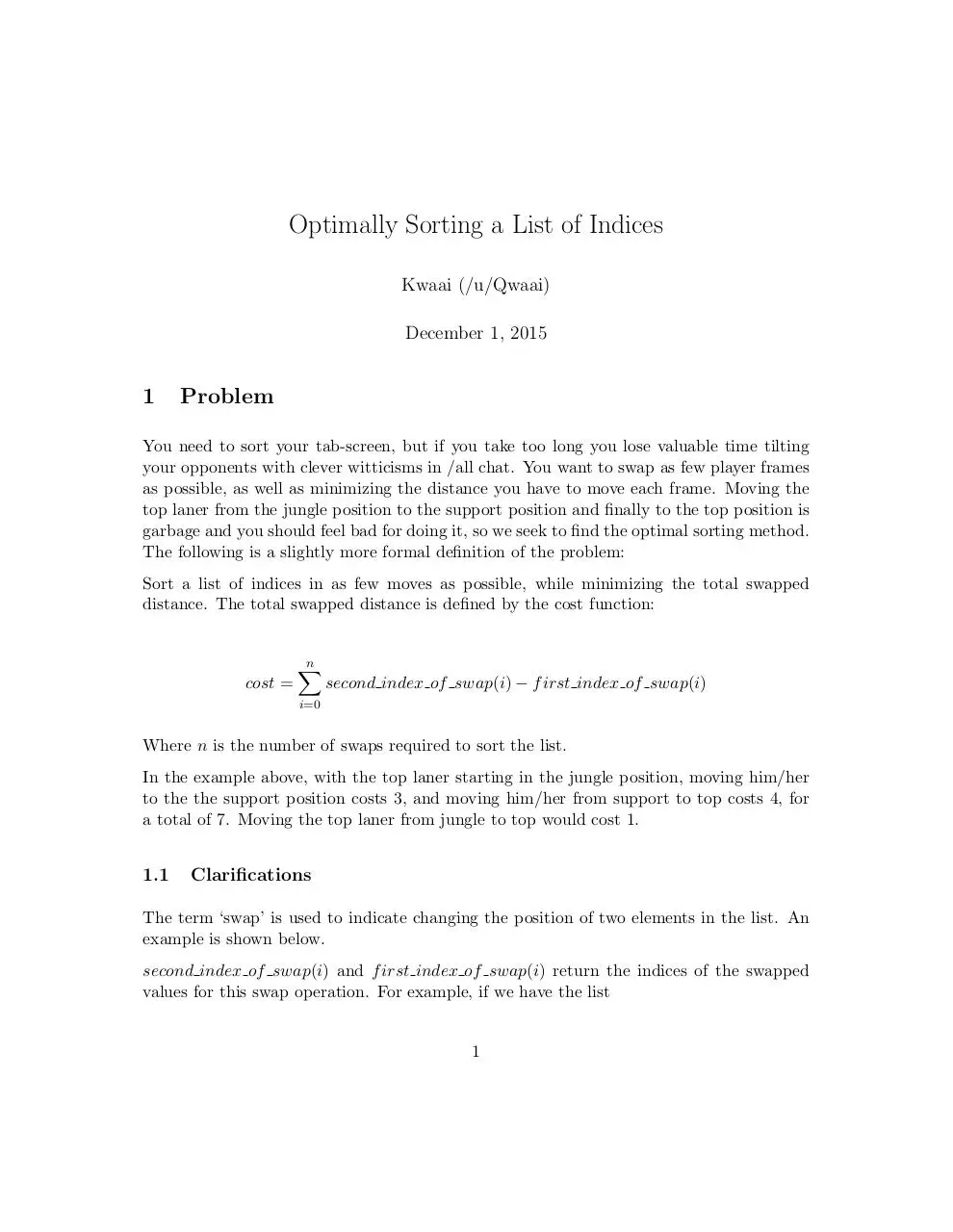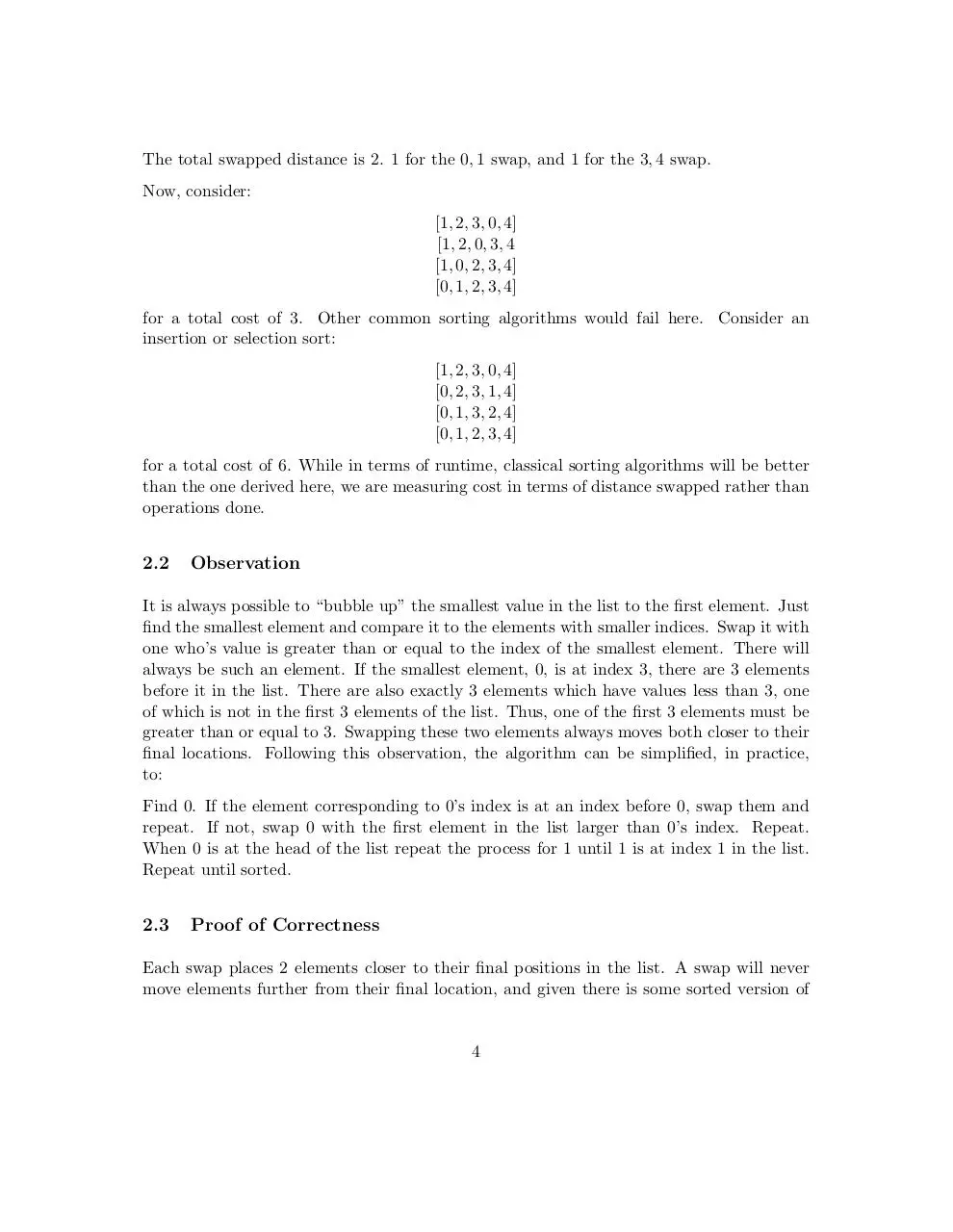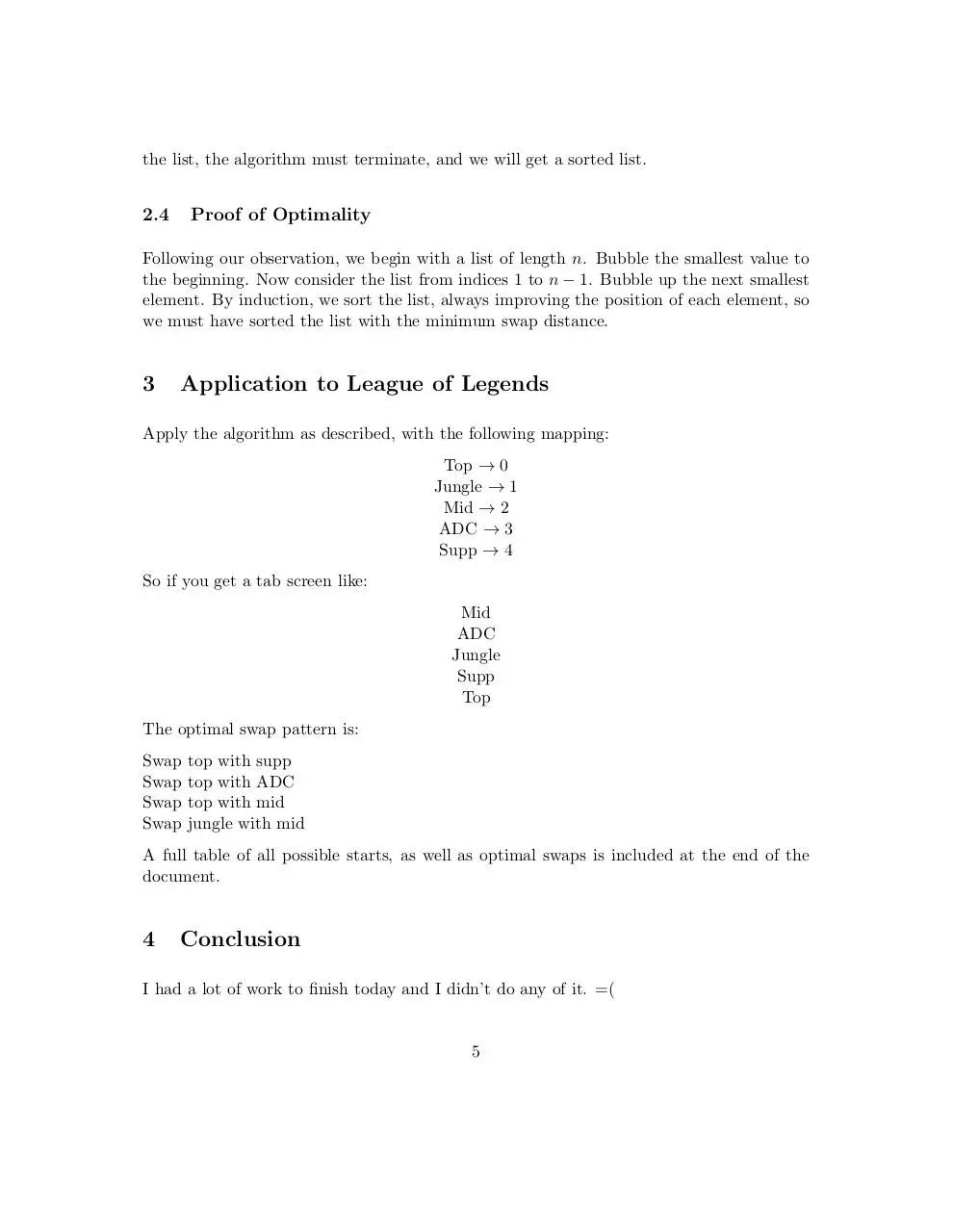tabsort (PDF)
File information
This PDF 1.5 document has been generated by XeTeX output 2015.12.01:2117 / xdvipdfmx (20140317), and has been sent on pdf-archive.com on 02/12/2015 at 03:48, from IP address 74.67.x.x.
The current document download page has been viewed 641 times.
File size: 39.64 KB (28 pages).
Privacy: public file





File preview
Optimally Sorting a List of Indices
Kwaai (/u/Qwaai)
December 1, 2015
1
Problem
You need to sort your tab-screen, but if you take too long you lose valuable time tilting
your opponents with clever witticisms in /all chat. You want to swap as few player frames
as possible, as well as minimizing the distance you have to move each frame. Moving the
top laner from the jungle position to the support position and finally to the top position is
garbage and you should feel bad for doing it, so we seek to find the optimal sorting method.
The following is a slightly more formal definition of the problem:
Sort a list of indices in as few moves as possible, while minimizing the total swapped
distance. The total swapped distance is defined by the cost function:
cost =
n
∑
second index of swap(i) − f irst index of swap(i)
i=0
Where n is the number of swaps required to sort the list.
In the example above, with the top laner starting in the jungle position, moving him/her
to the the support position costs 3, and moving him/her from support to top costs 4, for
a total of 7. Moving the top laner from jungle to top would cost 1.
1.1
Clarifications
The term ‘swap’ is used to indicate changing the position of two elements in the list. An
example is shown below.
second index of swap(i) and f irst index of swap(i) return the indices of the swapped
values for this swap operation. For example, if we have the list
1
[1, 0, 2, 3]
and we swap the 0 and 1:
second index of swap(i) = 1
f irst index of swap(i) = 0
so the cost for that swap is:
1−0=1
and the list now appears as:
[0, 1, 2, 3]
1.2
Assumptions
The input list (of length n) will be structured such that the indices it contains, when sorted,
will be in the form:
[0, 1, ...n − 1]
The input list is initially randomly shuffled. We make no assumption as to differing likelihoods of top lane being more in demand than, say, support, which would create a bias of
top laners starting earlier in the list.
1.3
Observations
After a swap, one element will be in it’s final location and can be ignored for the remainder
of the problem, for reasons stated above. The other element will have started some distance
from its final location. It’s new location is either closer to, further from, or the same
distance to it’s final location as it’s initial location was. If it is further from it’s final
location we have increased the cost of some future swap, as that distance will have to be
swapped over in the future. If it is closer, we have decreased the cost of some future swap.
If it is the same we have done nothing to the cost of a future swap.
2
2
Algorithm
Our observations lend to a greedy approach, and the cost function is intuitive: we pay for
the distance of the swap, but reclaim for distance we don’t have to pay for in future swaps.
Thus, in determining which swap to make on a given iteration:
argmin
n−1
∑ n−1
∑
|i − j| + max(∆L[i], ∆L[j])
i=0 j=0
Such that:
i<j
∆L[x] represents the change in distance of an
element from it’s initial position to it’s final position
For example, given the list:
[1, 0, 3, 2, 4]
The cost of swapping 1 and 0 is:
|0 − 1| + max((−1), (−1)) = 0
The negative deltas indicate each number has moved closer to it’s final position. Astute
readers will note that the cost of this swap is 0. This corresponds to having payed 1 to
swap an element into it’s final location (we only moved it one index over), and then having
moved another element one spot closer to it’s final location.
The algorithm, in total, is as follows:
While the list is unsorted, determine the best swap to make, such that one of the elements
in the swap is placed in its final location while minimizing the distance the other element
has to travel to its final location.
2.1
Examples
Given the list:
[1, 0, 2, 4, 3]
we make the following swaps:
[0, 1, 2, 4, 3] (0 and 1)
[0, 1, 2, 3, 4] (3 and 4)
3
The total swapped distance is 2. 1 for the 0, 1 swap, and 1 for the 3, 4 swap.
Now, consider:
[1, 2, 3, 0, 4]
[1, 2, 0, 3, 4
[1, 0, 2, 3, 4]
[0, 1, 2, 3, 4]
for a total cost of 3. Other common sorting algorithms would fail here. Consider an
insertion or selection sort:
[1, 2, 3, 0, 4]
[0, 2, 3, 1, 4]
[0, 1, 3, 2, 4]
[0, 1, 2, 3, 4]
for a total cost of 6. While in terms of runtime, classical sorting algorithms will be better
than the one derived here, we are measuring cost in terms of distance swapped rather than
operations done.
2.2
Observation
It is always possible to “bubble up” the smallest value in the list to the first element. Just
find the smallest element and compare it to the elements with smaller indices. Swap it with
one who’s value is greater than or equal to the index of the smallest element. There will
always be such an element. If the smallest element, 0, is at index 3, there are 3 elements
before it in the list. There are also exactly 3 elements which have values less than 3, one
of which is not in the first 3 elements of the list. Thus, one of the first 3 elements must be
greater than or equal to 3. Swapping these two elements always moves both closer to their
final locations. Following this observation, the algorithm can be simplified, in practice,
to:
Find 0. If the element corresponding to 0’s index is at an index before 0, swap them and
repeat. If not, swap 0 with the first element in the list larger than 0’s index. Repeat.
When 0 is at the head of the list repeat the process for 1 until 1 is at index 1 in the list.
Repeat until sorted.
2.3
Proof of Correctness
Each swap places 2 elements closer to their final positions in the list. A swap will never
move elements further from their final location, and given there is some sorted version of
4
the list, the algorithm must terminate, and we will get a sorted list.
2.4
Proof of Optimality
Following our observation, we begin with a list of length n. Bubble the smallest value to
the beginning. Now consider the list from indices 1 to n − 1. Bubble up the next smallest
element. By induction, we sort the list, always improving the position of each element, so
we must have sorted the list with the minimum swap distance.
3
Application to League of Legends
Apply the algorithm as described, with the following mapping:
Top → 0
Jungle → 1
Mid → 2
ADC → 3
Supp → 4
So if you get a tab screen like:
Mid
ADC
Jungle
Supp
Top
The optimal swap pattern is:
Swap
Swap
Swap
Swap
top with supp
top with ADC
top with mid
jungle with mid
A full table of all possible starts, as well as optimal swaps is included at the end of the
document.
4
Conclusion
I had a lot of work to finish today and I didn’t do any of it. =(
5
[top,
[top,
[top,
[top,
[top,
[top,
jungle,
jungle,
jungle,
jungle,
jungle,
jungle,
mid,
mid,
mid,
mid,
mid,
mid,
baby,
baby,
baby,
baby,
baby,
baby,
parent]
parent]
parent]
parent]
parent]
parent]
[top,
[top,
[top,
[top,
[top,
[top,
jungle,
jungle,
jungle,
jungle,
jungle,
jungle,
mid,
mid,
mid,
mid,
mid,
mid,
parent, baby]
parent, baby]
parent, baby]
parent, baby]
baby, parent]
baby, parent]
[top,
[top,
[top,
[top,
[top,
[top,
jungle,
jungle,
jungle,
jungle,
jungle,
jungle,
baby, mid,
baby, mid,
baby, mid,
mid, baby,
mid, baby,
mid, baby,
[top,
[top,
[top,
[top,
[top,
[top,
jungle,
jungle,
jungle,
jungle,
jungle,
jungle,
baby, parent, mid]
baby, parent, mid]
baby, parent, mid]
mid, baby, parent]
mid, baby, parent]
mid, baby, parent]
[top,
[top,
[top,
[top,
[top,
[top,
jungle,
jungle,
jungle,
jungle,
jungle,
jungle,
parent, mid, baby]
parent, mid, baby]
parent, mid, baby]
mid, baby, parent]
mid, baby, parent]
mid, baby, parent]
parent]
parent]
parent]
parent]
parent]
parent]
[top, jungle, parent, baby, mid]
[top, jungle, parent, baby, mid]
[top, jungle, parent, baby, mid]
6
[top, jungle, mid, baby, parent]
[top, jungle, mid, baby, parent]
[top, jungle, mid, baby, parent]
[top,
[top,
[top,
[top,
[top,
[top,
mid, jungle,
mid, jungle,
jungle, mid,
jungle, mid,
jungle, mid,
jungle, mid,
baby,
baby,
baby,
baby,
baby,
baby,
parent]
parent]
parent]
parent]
parent]
parent]
[top,
[top,
[top,
[top,
[top,
[top,
mid, jungle,
mid, jungle,
jungle, mid,
jungle, mid,
jungle, mid,
jungle, mid,
parent, baby]
parent, baby]
parent, baby]
parent, baby]
baby, parent]
baby, parent]
[top,
[top,
[top,
[top,
[top,
[top,
mid, baby, jungle,
mid, baby, jungle,
jungle, mid, baby,
jungle, mid, baby,
jungle, mid, baby,
jungle, mid, baby,
[top,
[top,
[top,
[top,
[top,
[top,
mid, baby, parent, jungle]
mid, baby, parent, jungle]
jungle, mid, baby, parent]
jungle, mid, baby, parent]
jungle, mid, baby, parent]
jungle, mid, baby, parent]
[top,
[top,
[top,
[top,
[top,
[top,
mid, parent, jungle, baby]
mid, parent, jungle, baby]
jungle, mid, baby, parent]
jungle, mid, baby, parent]
jungle, mid, baby, parent]
jungle, mid, baby, parent]
parent]
parent]
parent]
parent]
parent]
parent]
7
[top,
[top,
[top,
[top,
[top,
[top,
mid, parent, baby, jungle]
mid, parent, baby, jungle]
jungle, mid, baby, parent]
jungle, mid, baby, parent]
jungle, mid, baby, parent]
jungle, mid, baby, parent]
[top,
[top,
[top,
[top,
[top,
[top,
baby, jungle, mid,
baby, jungle, mid,
jungle, mid, baby,
jungle, mid, baby,
jungle, mid, baby,
jungle, mid, baby,
[top,
[top,
[top,
[top,
[top,
[top,
baby, jungle, parent, mid]
baby, jungle, parent, mid]
jungle, mid, baby, parent]
jungle, mid, baby, parent]
jungle, mid, baby, parent]
jungle, mid, baby, parent]
[top,
[top,
[top,
[top,
[top,
[top,
baby, mid, jungle,
baby, mid, jungle,
jungle, mid, baby,
jungle, mid, baby,
jungle, mid, baby,
jungle, mid, baby,
[top,
[top,
[top,
[top,
[top,
[top,
baby, mid, parent, jungle]
baby, mid, parent, jungle]
jungle, mid, baby, parent]
jungle, mid, baby, parent]
jungle, mid, baby, parent]
jungle, mid, baby, parent]
parent]
parent]
parent]
parent]
parent]
parent]
parent]
parent]
parent]
parent]
parent]
parent]
[top, baby, parent, jungle, mid]
[top, baby, parent, jungle, mid]
8
[top,
[top,
[top,
[top,
jungle,
jungle,
jungle,
jungle,
parent, baby, mid]
mid, baby, parent]
mid, baby, parent]
mid, baby, parent]
[top,
[top,
[top,
[top,
[top,
[top,
baby, parent, mid, jungle]
baby, parent, mid, jungle]
jungle, mid, baby, parent]
jungle, mid, baby, parent]
jungle, mid, baby, parent]
jungle, mid, baby, parent]
[top,
[top,
[top,
[top,
[top,
[top,
parent, jungle, mid, baby]
parent, jungle, mid, baby]
jungle, mid, baby, parent]
jungle, mid, baby, parent]
jungle, mid, baby, parent]
jungle, mid, baby, parent]
[top,
[top,
[top,
[top,
[top,
[top,
parent, jungle, baby, mid]
parent, jungle, baby, mid]
jungle, mid, baby, parent]
jungle, mid, baby, parent]
jungle, mid, baby, parent]
jungle, mid, baby, parent]
[top,
[top,
[top,
[top,
[top,
[top,
parent, mid, jungle, baby]
parent, mid, jungle, baby]
jungle, mid, baby, parent]
jungle, mid, baby, parent]
jungle, mid, baby, parent]
jungle, mid, baby, parent]
[top,
[top,
[top,
[top,
[top,
parent, mid, baby, jungle]
parent, mid, baby, jungle]
jungle, mid, baby, parent]
jungle, mid, baby, parent]
jungle, mid, baby, parent]
9
Download tabsort
tabsort.pdf (PDF, 39.64 KB)
Download PDF
Share this file on social networks
Link to this page
Permanent link
Use the permanent link to the download page to share your document on Facebook, Twitter, LinkedIn, or directly with a contact by e-Mail, Messenger, Whatsapp, Line..
Short link
Use the short link to share your document on Twitter or by text message (SMS)
HTML Code
Copy the following HTML code to share your document on a Website or Blog
QR Code to this page

This file has been shared publicly by a user of PDF Archive.
Document ID: 0000318671.